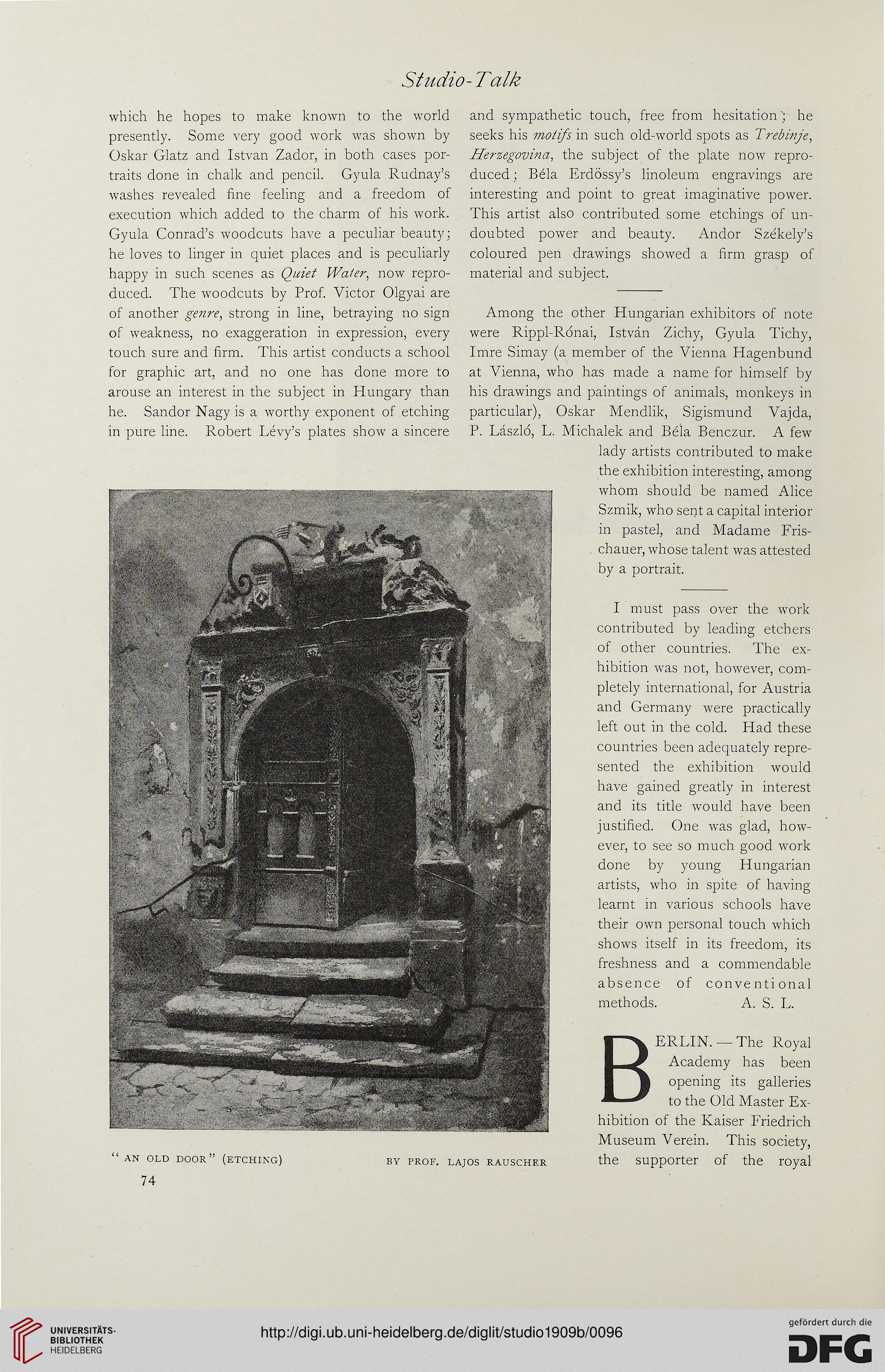Studio-Talk
I must pass over the work
contributed by leading etchers
of other countries. The ex-
hibition was not, however, com-
pletely international, for Austria
and Germany were practically
left out in the cold. Had these
countries been adequately repre-
sented the exhibition would
have gained greatly in interest
and its title would have been
justified. One was glad, how-
ever, to see so much good work
done by young Hungarian
artists, who in spite of having
learnt in various schools have
their own personal touch which
shows itself in its freedom, its
freshness and a commendable
absence of conventional
methods. A. S. L.
which he hopes to make known to the world
presently. Some very good work was shown by
Oskar Glatz and Istvan Zador, in both cases por-
traits done in chalk and pencil. Gyula Rudnay’s
washes revealed fine feeling and a freedom of
execution which added to the charm of his work.
Gyula Conrad’s woodcuts have a peculiar beauty;
he loves to linger in quiet places and is peculiarly
happy in such scenes as Quiet Water, now repro-
duced. The woodcuts by Prof. Victor Olgyai are
of another genre, strong in line, betraying no sign
of weakness, no exaggeration in expression, every
touch sure and firm. This artist conducts a school
for graphic art, and no one has done more to
arouse an interest in the subject in Hungary than
he. Sandor Nagy is a worthy exponent of etching
in pure line. Robert Levy’s plates show a sincere
AN OLD DOOR” (ETCHING) BY PROF. LAJOS RAUSCHER
74
BERLIN. —The Royal
Academy has been
opening its galleries
to the Old Master Ex-
hibition of the Kaiser Friedrich
Museum Verein. This society,
the supporter of the royal
and sympathetic touch, free from hesitation'; he
seeks his motifs in such old-world spots as Trebivje,
Herzegovina, the subject of the plate now repro-
duced ; Bela Erdossy’s linoleum engravings are
interesting and point to great imaginative power.
This artist also contributed some etchings of un-
doubted power and beauty. Andor Sze'kely’s
coloured pen drawings showed a firm grasp of
material and subject.
Among the other Hungarian exhibitors of note
were Rippl-Ronai, Istvan Zichy, Gyula Tichy,
Imre Simay (a member of the Vienna Hagenbund
at Vienna, who has made a name for himself by
his drawings and paintings of animals, monkeys in
particular), Oskar Mendlik, Sigismund Vajda,
P. Laszlo, L. Michalek and Bela Benczur. A few
lady artists contributed to make
the exhibition interesting, among
whom should be named Alice
Szmik, who sept a capital interior
in pastel, and Madame Fris-
chauer, whose talent was attested
by a portrait.
I must pass over the work
contributed by leading etchers
of other countries. The ex-
hibition was not, however, com-
pletely international, for Austria
and Germany were practically
left out in the cold. Had these
countries been adequately repre-
sented the exhibition would
have gained greatly in interest
and its title would have been
justified. One was glad, how-
ever, to see so much good work
done by young Hungarian
artists, who in spite of having
learnt in various schools have
their own personal touch which
shows itself in its freedom, its
freshness and a commendable
absence of conventional
methods. A. S. L.
which he hopes to make known to the world
presently. Some very good work was shown by
Oskar Glatz and Istvan Zador, in both cases por-
traits done in chalk and pencil. Gyula Rudnay’s
washes revealed fine feeling and a freedom of
execution which added to the charm of his work.
Gyula Conrad’s woodcuts have a peculiar beauty;
he loves to linger in quiet places and is peculiarly
happy in such scenes as Quiet Water, now repro-
duced. The woodcuts by Prof. Victor Olgyai are
of another genre, strong in line, betraying no sign
of weakness, no exaggeration in expression, every
touch sure and firm. This artist conducts a school
for graphic art, and no one has done more to
arouse an interest in the subject in Hungary than
he. Sandor Nagy is a worthy exponent of etching
in pure line. Robert Levy’s plates show a sincere
AN OLD DOOR” (ETCHING) BY PROF. LAJOS RAUSCHER
74
BERLIN. —The Royal
Academy has been
opening its galleries
to the Old Master Ex-
hibition of the Kaiser Friedrich
Museum Verein. This society,
the supporter of the royal
and sympathetic touch, free from hesitation'; he
seeks his motifs in such old-world spots as Trebivje,
Herzegovina, the subject of the plate now repro-
duced ; Bela Erdossy’s linoleum engravings are
interesting and point to great imaginative power.
This artist also contributed some etchings of un-
doubted power and beauty. Andor Sze'kely’s
coloured pen drawings showed a firm grasp of
material and subject.
Among the other Hungarian exhibitors of note
were Rippl-Ronai, Istvan Zichy, Gyula Tichy,
Imre Simay (a member of the Vienna Hagenbund
at Vienna, who has made a name for himself by
his drawings and paintings of animals, monkeys in
particular), Oskar Mendlik, Sigismund Vajda,
P. Laszlo, L. Michalek and Bela Benczur. A few
lady artists contributed to make
the exhibition interesting, among
whom should be named Alice
Szmik, who sept a capital interior
in pastel, and Madame Fris-
chauer, whose talent was attested
by a portrait.




